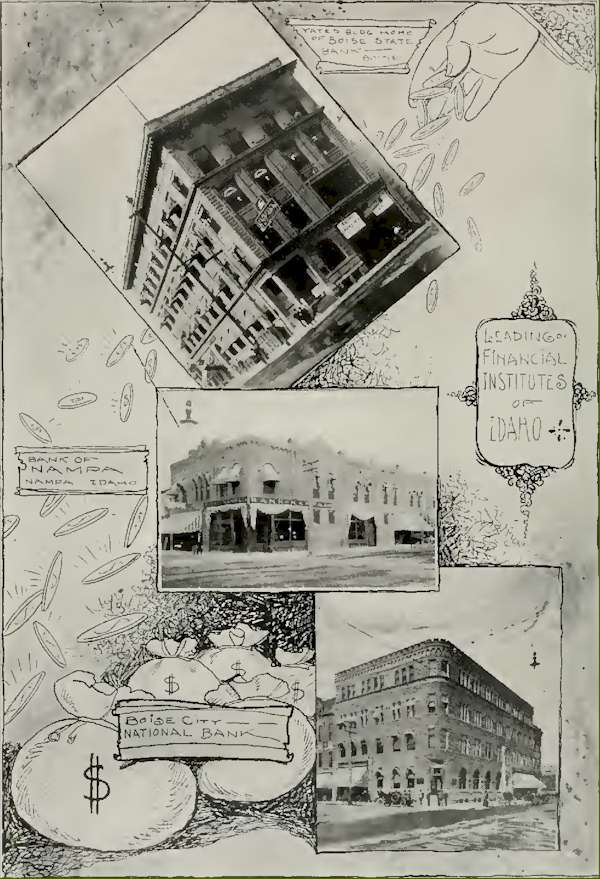Banking in Idaho
From a modest beginning in a frontier
town to the largest and strongest institution in a wealthy and
growing State is an enviable record, but such is the history of
the Boise City National Bank. The bank was organized in April,
1886, by Alfred Eoff, H. B. Eastman, Joseph Perrault, and
others, with a capital of $100,000. Mr. Eoff, (well known to the
bankers of the Pacific Coast) was elected cashier and manager
and occupied that position for over twenty years, and until the
sale of the stock of the bank to the present management in July,
1906. In the death of Mr. Eoff last year the community suffered
the loss of a valuable citizen and the banking fraternity a
sound financier of the old school. The other officers were:
Henry Wadsworth, president; H. B. Eastman, vice-president;
Joseph Perrault, assistant cashier. In July, 1888, Mr. Perrault
resigned and Walter S. Bruce was elected to succeed him. The
only changes in the officers from this time until the change in
the control was the election of H. B. Eastman as president in
January, 1904, to succeed Mr. Wadsworth, and the election of Mr.
Began as vice-president.
In July, 1906, the control of the
bank passed into new hands, all of the old directors retiring
except Mr. Regan and Mr. Eastman. The new officers elected were:
F. R. Coffin, president; Timothy Regan, vice-president; J. E.
Clinton, Jr., cashier; Fred Brown and B. W. Walker, assistant
cashiers. The business and influence of the institution has
steadily increased and the management has established a
reputation for being progressive and conservative. This bank is
one of the few institutions that can show an uninterrupted
period of growth. During the financial flurry of last year their
deposits showed a marked increase, and they were enabled to
extend aid to a great number of banks in southern Idaho. This
fact, together with the general policy of caring for their
correspondents and customers, has given them connections with
nearly every point in the Northwest.
The Boise City National Bank is the
government depository for the State of Idaho and has been
specially designated as depository for the post office
department. Their capital is now $250,000, with a surplus and
profits of $150,000. A recent statement shows their deposits two
million and a quarter; loans over a million and a half, and cash
and sight exchange one million, making their reserve over 40 per
cent.
The bank occupies its own modern
office building, a massive stone structure worth a quarter of a
million dollars. The entire fourth floor of the building is
occupied by the Boise Commercial Club, it having been prepared
for them especially by the bank.
The Bank of Nampa
Among the towns of Idaho which are fast coming to the front and
which are making that State one of the most desirable in the
West is Nampa. It is here that business is carried on in an
energetic and open-handed way and the merchants of that city are
strictly up-to-date and progressive. That merchants do make a
town is generally conceded and after one discovers the hustling,
bustling stores, it is natural to inquire as to the status of
the home bank. The Bank of Nampa is the oldest bank in the city
and one of the best known in the State. The report of this bank
shows conclusively that it can be ranked with any of the banks
throughout the country in comparison with population.
It was founded in 1899 and the
capitalization is $50,000. The directors of the company are all
men of sound business ability and alive at all times to the
opportunities afforded to those who come to Idaho. They wanted a
good sound banking institution and when the Bank of Nampa was
organized these men gave it their full support, both moral and
financial. The officers are all men drilled in the hard, school
of experience and men who have studied the banking business from
ground up. It is that fact, coupled with the sure-to-win methods
of fair dealing and prudent, progressive policy that have made
this bank one of the strongest and most substantial in the
entire Gem State. The officers have at all times been willing to
advance money on the legitimate enterprises which the State
affords, and their experience in the business has qualified them
to distinguish between the legitimate and the doubtful projects,
an absolutely safe policy being at all times the one followed.
The officers of the bank are: John W.
Givens, president; J. A. Givens, vice-president; T. E. Munhall,
cashier; C. E. Lore, assistant cashier. All of these men have
been from ten to twenty years learning the many intricacies of
the business and the success of the institution can be traced to
the strict business principles, and honest and fair methods
employed and the progressiveness of the men at the helm.
Far-sighted to a degree, they have built the business up from a
small country bank to one of prominence and importance. The
directors, namely, John W. Givens, J. S. Hickey, C. R. Hickey,
J. A. Givens, and Eugene Emerson, are all men prominent in
business circles in Nampa and of the State, and they have helped
to make the bank what it is to-day. They all have faith in the
future of Idaho, and naturally of Nampa, and that this town will
someday be one of the biggest in the State is their prediction.
Banking on this and being assured that this will be soon, they
are building up one of the foundations for a big city, a banking
institution which is worthy of the name and of the men who are
behind it.
Boise State Bank
There is no business institution in
Idaho that is better known or is on a more solid basis than the
Boise State Bank of Boise. Although one of the newer banking
houses, having been organized in 1906, it has taken rank with
many of the older ones and is enjoying great prosperity. The
capital of the Boise State Bank is $50,000. The officers at this
time are: president, Edward Payne, a wealthy and retired
sheepman; vice-president, Arthur Pence, prominent as a stockman
and well known in Idaho politics; cashier, E. S. Clapp, formerly
a Michigan banker and for a number of years cashier of the First
Bank of Council, Idaho.
Recently the Boise State Bank began
its occupancy of fine quarters in a building on one of the most
prominent corners of Boise.


Index

Source: Sketches of the Inter-Mountain
States, Utah, Idaho and Nevada, Published by The Salt Lake
Tribune, Salt Lake City, Utah, 1909
|


